Benjamin Franklin by Walter Isaacson

My apologies to the unknown library patron whom I forced to return this book so that I could check it out, right before the libraries shut down indefinitely. If I'd known, you could have kept it.
First, this book is long and surprisingly dull for a popular biography. Second, as of page 92, where I finally decided to quit, there was remarkably little historical detail - it focuses in on the biographical aspects to the point that it's almost divorced from history, unusual for a biography of someone who lived more than 200 years ago. Third, it is chock-full of repetitive adoration of Franklin: barely a page passes without our being told that he was pragmatic and that whatever he's doing at the moment illustrates his pragmatic character. Or earnest, canny, frugal, etc. etc. This is especially jarring given that much of the behavior described isn't actually admirable: driving another newspaper editor out of business to clear the field to launch his own paper; writing anonymous letters to his own paper criticizing his competitors and praising himself, including for his restraint in not criticizing his competitors; allowing his wife to be openly nasty to his son, her stepson; and publishing a piece a few weeks after his marriage about how wives need to serve their husbands in everything and "deny yourself the trivial satisfaction of your own will," among many similarly unfortunate exhortations. Isaacson treats all this material uncritically, and I don't have much use for biographies that can't take an honest and balanced look at their subject, however widely loved that person might be. But Isaacson seems too enamored of Franklin's self-improvement schemes, all discussed in great detail, to do so.
At any rate, there are plenty of Franklin biographies out there and I can't say I have much use for this one. If only the library would take it back!
If You're In My Office, It's Already Too Late by James Sexton
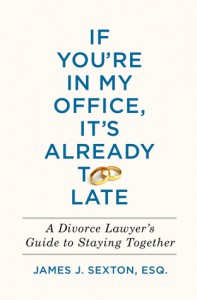
This is an entertaining self-help book that mixes anecdotes from the author’s experiences as a divorce lawyer with marriage advice he draws from those experiences. Awhile back I read some entertaining medical memoirs and wished the same was available from the legal profession, which it generally isn’t; books by lawyers about their work tend to be grim or outraged or both. Sexton is neither, and his anecdotes are entertaining and sometimes even funny, though relatively brief. (And the outrage might sometimes be on the reader’s end, like when Sexton insists that because he was once hired by a drug-dealing, abusive pimp for a child support case, he was somehow ethically compelled to represent the guy in every case he ever had thereafter, including to get custody of his young daughter. Yeah, right.) Whether because Sexton isn’t a journalist or because the anecdotes are here to illustrate the advice, they don’t have a lot of depth to them, but there is a lot of humorously-recounted drama, so there’s that.
As far as the relationship advice, it ranges from the thought-provoking to the somewhat questionable, as in probably any self-help book, with much of it being fairly banal. That said, people have been writing about relationships for hundreds of years if not longer, so perhaps it’s not fair to expect this author to have a lot of strikingly new insights. Writing about how to sustain a marriage based on a lot of stories of failed marriages at times leads the author into pessimism (he’s unconvinced marriage counseling helps anyone, a phenomenon perhaps explained by the title of his book) and speculation. For instance, many of his clients, and the author himself, have found that having their children for limited, set times makes them focus more on the kids while they’re together rather than taking them for granted as they did before, so he suggests intact couples also try taking turns “having the kids,” without any evidence from anyone who’s ever actually tried this. Still an interesting idea though. And in general, Sexton seems to take a pretty realistic and grounded view of relationships, without descending into sweeping gender stereotypes as a lot of authors on the subject seem to do.
So, not particularly earth-shattering, but interesting nonetheless. Worth a read if you’re in the market for this sort of thing.
 4
4
The Age of Wonder by Richard Holmes
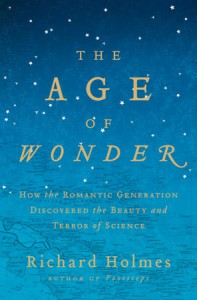
This is an entertaining and informative, if selective, group biography of several Enlightenment scientists, as well as a broader cultural history of science, art and adventure. It begins in the 1760s, with the voyage of wealthy naturalist Joseph Banks to Tahiti with Captain Cook; continues with brother and sister astronomers William and Caroline Hershel, who emigrated from Hanover to England; and in the later sections is largely focused on chemist and general polymath Humphrey Davy. Overall it covers scientific developments and the art they inspired through the end of the 1820s, more or less chronologically and overwhelmingly focused on England. More self-contained chapters explore the rise and fall of hot-air ballooning, explorer Mungo Park’s expeditions to West Africa, and the views of science espoused in Frankenstein, both Mary Shelley’s novel and its theater adaptations.
So: the book is wide-ranging, it draws together multiple disciplines, it’s intelligent and detailed as well as readable and entertaining. It draws complex and sympathetic portraits of its principle subjects, detailed enough that one gets a real sense of their personalities and forms opinions of them accordingly. (I liked Caroline Herschel, though she sounded a bit difficult in person. The charismatic and showy Davy turned me off a bit.) It’s much more history and biography than science text, but the author is certainly interested in the science and in the process of scientific discovery itself: when did people realize they’d made a groundbreaking discovery? Why did some potentially groundbreaking discoveries languish for years without seeing their potential realized? For instance, Davy had a lot of fun experimenting with laughing gas – getting himself and his friends and patients high (or knocking them right out) with variable quantities of it and recording their experiences – but never made the conceptual leap to the idea of using it for surgery; instead, the whole concept of anesthesia had to wait another two generations.
I was left with some questions about how Holmes chose his subjects. Histories of science (and everything else) available in English tend to be overwhelmingly Anglocentric, which is frustrating when many of the most important and influential scientists of the time (such as Lavoisier and Linnaeus) were not English and therefore don’t seem to feature in any popular histories. Even within England, I was sometimes a little confused about why we were reading about certain people and not others: Henry Cavendish is mentioned over and over for his importance to chemistry, but we don’t learn about him at all. Obviously an author has to draw the line somewhere to keep the book from being overpopulated – and Holmes does provide satisfyingly detailed biographies of Banks, the Herschels, and Davy, as well as shorter accounts of numerous other people. He seems to romanticize the explorers a bit much given the subsequent history of colonialism, though, and I wished he’d written a bit more about women in science at the time. In some ways Caroline Herschel seems to have had it very easy, as she was entering a field already dominated by her brother; no one seems to have discounted her abilities or discoveries on account of her gender, though she didn’t get much remuneration either.
At any rate, this is a somewhat time-consuming read, but also a compelling one. You’ll learn a lot on some fairly narrow subjects and come away with a new appreciation for a very different kind of science – much more ad hoc, free-flowing and accessible – than we see today.
Nine Lives by William Dalrymple
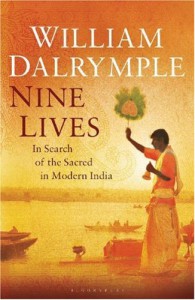
This is a fascinating book, in which the author captures nine particularly compelling stories of lives defined by religion in India, generally in unusual or extreme ways. The most intense stories come at the beginning: the Jain nun who ritually starves herself to death while her best friend looks on; the prison warden who spends three months of the year as a dancer believed to be possessed by a god. But they’re all interesting, including a Tibetan monk who renounced his vows to fight the Chinese; an illiterate performer of ancient epics; and a manufacturer of idols. The author relates the stories in his subjects’ own words (presumably cleaned up a bit for print), without judgment, and supplements them with information about the history and wider context of their particular practices. The book makes no pretensions to being representative. These nine people – five men and four women, and their communities – simply happened to be striking to him. Most of the stories focus on distinct traditions within Hinduism, though there’s one Sufi story set in Pakistan, as well as the Tibetan monk and Jain nuns. They’re all intensely invested in their faiths, which for most of them have come to form their entire community. Except perhaps for the idol manufacturer, they’re also quite marginalized: they have always been poor, or they gave up relative privilege, possessions, even family relationships, to take to the roads as a spiritual calling. Many talk about having been spiritual since childhood, but most of these lives are also examples of people picking up the pieces after trauma and loss. All of which makes for a heartfelt, captivating book that promises no more than it can deliver, that doesn’t water down these people’s stories by trying to universalize them. And the book can stand on its own; it doesn’t need to deliver a lecture on religion in India, beyond providing background for these specific people. I think it’s more powerful that way, though I couldn’t help wanting to draw a larger meaning from it. These nine people’s relationships to religion were remarkable to me, as an American: I’m used to religiosity being largely about righteousness, power, and complacency, an excuse to look down on others or refrain from addressing social or environmental problems, or at best a way of staking a claim on a particular social identity. For these nine people, it’s something different: they seemed to be searching, rather than claiming to have all the answers, and one of the things they’re seeking are worthwhile and meaningful lives. But is this actually a difference between India and the U.S. overall? – I don’t know. (And perhaps if I had grown up around their traditions I would have seen more self-righteousness in these folks too.) Marginalized people all over the world turn to religion for the same reasons these nine people do, and India is hardly free of people who use religion for political and exclusionary ends. I would have liked Dalrymple to have drawn some conclusions – notably, the book has no epilogue – though I recognize that wasn’t his goal here. At any rate, quite a good book and one I would recommend, so long as you’re interested in reading about the lives of a few striking individuals rather than a broader sociological study.
Opium by Martin Booth
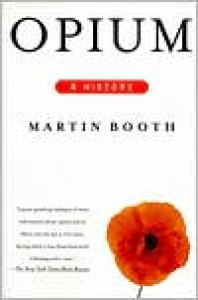
This book contains some interesting information and provides a broad and in-depth historical look at its topic. However, it’s a bit dull, rations its commas much too severely, has a tendency to overgeneralize, and its racial characterizations and blind spots are troubling. And by virtue of being published in 1996, before the current opiate crisis, it’s dated now, focusing mostly on the 19th and 20th centuries.
The early chapters provide a good overview of how opium is grown, its effects, and its use from antiquity through the 18th century. The author has a tendency to want to make everything about opium (like every image in the Rime of the Ancient Mariner – there’s a lot about Romantic poets here), but I still found this fairly interesting.
But its Anglocentric perspective becomes clear as it gets into the Opium Wars of the early 19th century and beyond, with wide-eyed details about drug smuggling and an approving view of the drug war. While it’s not exactly surprising that this white British author failed to draw the insights Alexander did in The New Jim Crow fourteen years later, I find literature about the drug war that doesn’t consider its racialized nature to be fairly worthless reading today. It’s like reading a history of the American South that never mentions black people – sure, you might still get some information from it, but how much that’s really useful? There’s even a howler about how increasing heroin use in black and Hispanic “ghettos” in American cities “so worried the FBN [predecessor of the DEA] that, in 1951, a mandatory minimum sentence of two years was instituted for a first conviction of narcotics possession.” Worried…. because “worry” (with its implications of stewardship and compassion) is what causes officials to throw poor young men of other races into prison for two years for a minor, first offense. Right.
Weird racial comments are even more prevalent regarding Asians: the “beautiful Oriental whores” of Hong Kong, the “native ignorance of hygiene” that caused illness from needle sharing in 19th century China (given that the hypodermic syringe wasn’t invented until the 1840s, I’m pretty sure its safe use was new to everybody at that time), the comment that “[t]he sight of opium addicts in the streets of Hong Kong was a commonplace which most Chinese ignored but which even long-term expatriate residents could seldom see without a shudder of sympathy.” Given that the author’s sources are overwhelmingly European, I’m not sure why he thinks it’s appropriate to contrast European feelings with Chinese action, unless it’s in service of some unsupported idea about Europeans having finer feelings, perhaps?
At any rate, I learned some stuff from this book, though I really only read the first half for its information and skimmed/skipped over the second with its cluelessness and racism. Worth looking at if you’re interested in the older historical aspects, less so for the modern history.
 2
2
The Emotional Craft of Fiction by Donald Maass
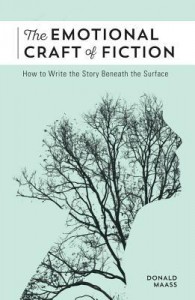
This is a provocative writing book. As always with these sorts of books, I think the best reaction is probably to take with you what’s useful and leave behind the rest after having given some consideration to it - if you're going to do something that's not generally advised, you want to be doing it deliberately, not thoughtlessly. And I think there’s a fair amount in here worthy of consideration, though it’s also sometimes less helpful than it could be, particularly when Maass devotes large portions of sections to quoting passages that worked for him, usually preceded with overly long explanations of what the book in question is about even when it’s not actually relevant to understanding the passage.
Now there are certainly some good insights and tips in here. For instance, on how to make character emotions effective for a reader (usually by writing around them in one way or another). There are also some insights and tips that I’m glad most writers don’t use. Maass points out, for instance, that the fictional characters you love most are probably in some way better and more admirable than the average person. And this is true for me. But at the same time, I don’t expect or even really want to fall in love with every book, but a large part of what I do want from fiction is a window into lives different from my own. I don’t want every protagonist to be a hero or every book to be about the triumph of the human spirit, or whatever other inflated universalizing language blurb-writers love to use. That’s exhausting and at a certain point I think it’s alienating. I like to read about real, flawed people (though Maass is right that for us to care, their everyday lives need to be rich with meaning). So, is writing about extraordinary, inspiring people a good idea for the individual author? Maybe. But please, don’t all do it at once!
Relatedly, Maass pushes back here against the idea that everything in a book needs to be action, no contemplation, and conflict, no harmony. Again, correctly in my reading experience, he points out that the books we love the most tend to be the ones where there is some warmth and emotional connectedness. I think he’s right that it’s rare to see this overdone, and more common to see bleak settings where strangers are hostile, friends useless and generic, families toxic, and protagonists isolated (though I would add: except for their love interest. Perhaps much of this is a clumsy way of isolating protagonists to make sure their romances are meaningful?). One of his more solid tips is to include in the opening not just a plot hook, but an emotional one: why should readers connect with this protagonist? (Because they care about a family member is a good suggested answer.) I find it a little odd that he discusses this whole topic almost in a vacuum though, without addressing the obvious question of how to square it with all that advice about every line consisting of conflict and action.
A couple of criticisms I saw before reading the book were about the author’s preference for classic literature, and a couple of weird gendered comments. Maybe it was because seeing these criticisms more than once made me expect worse, but I didn’t think either of these was much of a problem. Maass may connect most with classics, but his examples come from an admirable range of genres and represent both genders. The weirdest bit was his references to “women’s fiction,” which made me think he just calls all contemporary fiction by and about women that doesn’t fall into some other genre label “women’s fiction” (by which standard, of course, most of our celebrated male authors ought to be known as authors of “men’s fiction”). However, that’s a minor point in the scheme of the book.
There’s also the valid criticism that the author advises pulling back from very dark character emotions, this evidently being a place he doesn’t want to go. I would put this in the “take it if it helps, leave it if it doesn’t” bucket – I can maybe see where he’s coming from in that big enough emotions can take over the page through action alone without needing a lot of interior description, but I also didn’t find the passage he quoted as a good example of this to be emotionally effective. Instead it came across as weird and distancing.
At any rate, there’s plenty to dig into here and Maass offers a lot of concrete tips and exercises for writers, which will no doubt be useful in taking your fiction to the next level. I wouldn’t take it as gospel, but the same should probably be said for every how-to-write book.
 2
2
The Knife Man by Wendy Moore

A very engaging biography of a fascinating figure: despite being largely self-educated, John Hunter was an intellectual giant who pioneered experimental surgery and applied the scientific method to medicine in a time when most doctors put more stock in ancient texts than verifiable observations. Hunter extensively studied the anatomy of humans and animals through thousands of dissections, and even seems to have been moving toward his own theory of evolution, though his writings on the subject were not published during his lifetime (1728-1793).
By modern standards Hunter seems both enlightened (advocating restraint in surgery, and letting the body heal itself instead if it could; battlefield surgery in particular was so primitive it often made conditions worse) and cruel (animal vivisection, and seeking out unusual bodies of people who definitely did not want to be dissected – which, unfortunately for medicine at the time, was almost everyone). By the standards of his own time, too, he was polarizing: wildly popular among the hundreds of students whose educations he made a priority, but hated by many of his colleagues for being brusque and dismissive.
All-around, Hunter was a colorful figure with an interesting life, and he's given very sympathetic treatment here. I do wonder, as sometimes happens in biographies, if the author overstates the importance of her subject to history, or the prescience of some of his speculations. But her facts seem very well supported, in which case Hunter's contributions have been sadly under-discussed. Overall I found this book very readable, engaging and informative, and it paints a vivid picture of the times.
A note for the squeamish: I am squeamish and was a little concerned to read this based on comments in a few reviews, but I actually didn’t find it that bad. Early on a couple of surgical procedures are described somewhat explicitly, but the book is much more about Hunter’s life than about surgical methods. Where his work is described I didn’t find it overly gory, but then I did go in expecting the worst.
The Military Experience in the Age of Reason by Christopher Duffy

This is an informative and accessible work of history, broken out into relatively short sections for easy reading and reference. It answers such questions as: who were the soldiers and officers in 18th century Europe, where they did come from, what motivated them, how were armies structured, what was going on campaign like, what did infantry, cavalry and artillery each do in battle and out of it, what was medical care like, how did commanders disseminate orders to the troops, etc. Helpfully, Duffy quotes liberally from period accounts and authorities. As he comments at one point, this book is about the military experience rather than the details of strategy or logistics (and it's definitely not a narrative), but for a relatively compact book it covers a lot of ground. And it does so with engaging writing that's easy to read and doesn't require extensive pre-existing knowledge of the topic. It is Eurocentric and a bit snooty about it (Duffy comes very close to calling people from the Americas and the Middle East barbarians if he doesn’t outright say it). But if your interest is Europe, it is an excellent introduction to anyone looking for a better understanding of warfare in the period.
A Midwife's Tale by Laurel Thatcher Ulrich
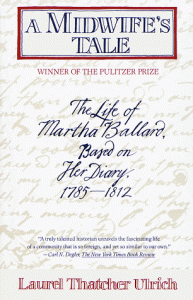
This is an interesting history/biography that’s both accessible and scholarly. Ulrich uses the bare-bones journal of a midwife in early New England, kept from age about 50 through her late 70s, to illuminate the social history of early Maine, as well as Martha Ballard’s own life and family drama. Ulrich clearly digs deep, cross-referencing many sources including official documents and other diarists from the area. The result is surprisingly rich, and includes some major events (a backwoods rebellion, a mass murder) as well as the details of Ballard’s life (visiting neighbors, gardening, delivering babies, marrying off her daughters and left in old age unhappily relying upon her son). Some of the information is surprising or illuminating: for instance, that 40% of first babies were conceived out of wedlock (overwhelmingly the parents soon married, however). Some of it seems fairly obvious now, though perhaps less so 30 years ago when this book was published: for instance, the fact that the women of Ballard’s small farming community had independent social and economic lives, typically visiting separately from their husbands and carrying on their own small-scale transactions with their neighbors. Meanwhile, Ballard had an eventful career in midwifery, often rushing from one home to another when multiple women were in labor at once, walking across frozen rivers or canoeing across partially-frozen ones to reach her patients. Ulrich presents her as part of a complicated network of “social medicine,” which ranged from neighbor women who showed up to assist at births or sit with the sick, through midwives who also acted as doctors, nurses, apothecaries and morticians depending on the situation, up through physicians, who were only beginning to monopolize the practice of medicine. In Ballard's lifetime doctors and midwives seem to have worked together mostly harmoniously – she witnessed several autopsies at the doctors’ invitation – though they sometimes butted heads. I would have liked to see a little more analysis of the medical techniques Ballard used. She was pretty clearly a practitioner of traditional rather than experimental medicine, but she also had a fantastic success rate for the time, losing only 5 mothers out of 1000 births. (Contrast with hospitals in London and Dublin, which had far higher maternal death rates, one as high as 1 in 5.) Ulrich mostly dismisses this with the notion that birth is a natural rather than a medical event, over-dramatized in fiction (though, 1 in 24 of the babies Ballard delivered were dead at birth or soon after). But what could those hospitals have been doing so badly wrong? Perhaps New England's colder climate and sparser population, making the spread of disease more difficult, was a major factor here? Overall Ulrich is more focused on the role of women in medicine than the effectiveness of the medicine, but I don’t think discussion of the latter would have undermined the impressiveness of the former at all. Yes, Ballard’s treatments included things like putting onions on people’s feet, but this was a time period when the most celebrated treatment promoted by the male medical establishment was bloodletting, which goes beyond just ineffective to be actually harmful. Overall, I would definitely recommend this to those who are interested as a strong piece of original scholarship that’s also quite interesting and accessible to those who enjoy popular history. Ulrich’s ability to draw meaning out of what might first appear to be a dry and abbreviated record is nothing short of impressive.
 3
3
The Invention of Air by Steven Johnson
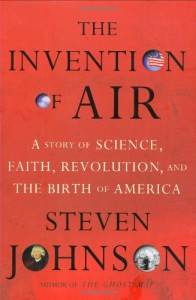
This short book is partly a biography of Joseph Priestley, a prolific and divisive 18th century figure who made influential discoveries in science (including discovering that plants replace carbon dioxide with oxygen, though he didn’t put it in quite those terms), helped found the Unitarian church, and was a bit of a political firebrand. Priestley’s life and work are interesting subjects, and with his eternal optimism, chaotic experimental procedures and determination to keep nothing – whether scientific discovery or radical religious opinion – to himself, he’s certainly a colorful figure. But this book is less impressive: there’s a little biography, a little science, a little religion, a little history, and it doesn’t add up to more than the sum of its parts. The author has a tendency to pontificate on subjects that seemed much more profound to him than they were to me, like connections between the location of coal deposits and Priestley’s life’s trajectory. But with generous margins and spacing, it’s a quick read, and I learned a bit from it even though I didn’t love it.
 3
3
The Best 10 Books I Read in 2019
Ordinarily I love to criticize, but the end of the year is my time to reflect on the best books I read during the year, and recommend them to all of you! I read a lot of great books in 2019, so it was a tough competition, but here are the best 10 books (out of 71 total that I finished) of the year.
Destiny Disrupted by Tamim Ansary (review)
An informative, wide-ranging, and even exciting history, this is a fascinating primer on the history of the Muslim world. It answered questions I didn’t even know I had, making sense of history all while telling a compelling narrative.
Crux: A Cross-Border Memoir by Jean Guerrero (review)
The best memoir I read in 2019, this is an intense story of a troubled family, in which the author peels back the layers of generational trauma in Mexico and the U.S. It is dark but brilliant.
Lost Connections by Johann Hari (review)
Possibly the most important book I read in 2019, this is the story of a journalist examining the science of depression, and realizing it doesn’t tell us what drug companies would have us believe. It provides a look at the real causes and solutions that’s relevant to anyone who wants to live a good life.
The Spirit Catches You and You Fall Down by Anne Fadiman(review)
An incredible work of journalistic nonfiction, the author uses the life of one family with a severely ill daughter to illuminate the culture clash between Hmong refugees and their American neighbors, particularly regarding medical treatment. A great book for anyone interested in cross-cultural misunderstanding and medicine, or the culture and recent history of the Hmong.
In the Country by Mia Alvar (review)
The best work of fiction I read in 2019, this is a fantastic short story collection, featuring Filipinos both at home and abroad. Great writing and great characters – this is one of those authors who can do in a short story what others require a novel to accomplish.
1491 by Charles C. Mann (review)
The most eye-opening book I read in 2019, this is a real history of the Americas before Columbus, stripping away myth and stereotype. A detailed account that will likely be new to most readers.
Among the Living and the Dead by Inara Verzemnieks(review)
The most poetic of my top books of 2019, this is a lovely multigenerational memoir of a family from Estonia – both those who fled as refugees, and those who stayed behind. It’s a thoughtful history of a place and its people as well as the author’s own journey of discovery.
Clear Light of Day by Anita Desai (review)
The best novel I read in 2019, this short book presents the emotionally layered and nuanced tale of four adult siblings and their difficult relationships.
Soldier Girls by Helen Thorpe (review)
A fascinating journalistic account of three women in the U.S. National Guard serving in Afghanistan and Iraq. It’s an honest, warts-and-all look at real life in the military from three very different perspectives, written by an incisive researcher and compelling storyteller.
Ants Among Elephants by Sujatha Gidla (review)
A fascinating family memoir of an untouchable family in 20th century India, focusing on the author’s uncle, an activist, and mother, a struggling professor. A great look at real lives behind the stereotypes.
And some honorable mentions, because I read more excellent books this year than a top-10 list will allow:
Night at the Fiestas
Olive Kitteridge
Catherine the Great: Portrait of a Woman
The Pursuit of Glory: Europe 1648-1815
Happy reading to all in 2020!
 3
3
A Royal Affair by Stella Tillyard

This is a very interesting historical biography, though weirdly conceived. The subtitle should be read not as a description of George III’s siblings but a qualification on who the book is about, and it's not George III, despite the cover image. Of the nine siblings, the youngest, Caroline Matilda, gets more than half of this book, and for good reason. Married at age 15 to the young King of Denmark, whose mental health was deteriorating rapidly, she embarked on an increasingly blatant affair with her husband’s doctor, Johann Struensee, and the pair grabbed the opportunity to take over the government of Denmark, dismiss all the old guard, and institute various Enlightenment reforms. Then within a couple of years everything came crashing down.
So, that’s a wild and fascinating story, and if her life had been a little longer maybe the whole book would have been about Caroline Matilda. As is the author fills out the rest of the book with the, by comparison, run-of-the-mill scandals of three of her brothers, Edward, William, and Henry, who being wealthy and privileged young men with no responsibilities, partied a lot and had love affairs and got secretly married. I think even Tillyard was a bit bored with them, especially the latter two, because her writing about their shenanigans tends to focus more on the women in their lives – who come across as more interesting, maybe because they had more to lose or maybe because Tillyard just finds women’s history more interesting. Don’t get me wrong, it’s entertaining to read about royal princes running about in disguise and being mistaken for highwaymen, but the brothers’ sections boil down to 18th century celebrity gossip, without larger import.
In the Introduction, Tillyard offers an enticing rationale for her choice of subject: “Biography . . . rarely dwells for very long on brothers and sisters and the importance they can have in one another’s lives. Perhaps because I am from a large family myself, my work has tended to go the other way, to be horizontal, seeking in the tangled web of brotherly and sisterly relations other clues to what makes us who we are.” But in focusing only on the scandalous siblings, I don’t think she quite lives up to that promise. George III is here for the role he plays in his younger siblings’ lives, but it’s in no way a biography of him; the three siblings who died between the ages of 15 and 20 get barely a mention; and Augusta, the eldest, who survived but was not scandalous, rarely appears. And there's no particular indication that the playboy brothers influenced Caroline Matilda or vice versa; these segments seem totally separate.
But it’s an interesting book nonetheless; Tillyard is a strong writer and storyteller, bringing the scenes of history to life, and seems to have done her research well. It felt a little dense – which may be as much an issue of typesetting as writing – and took longer to read than I’d have estimated from the page count, but for Caroline Matilda’s story in particular it is worth the read.
 3
3
The Pursuit of Glory by Tim Blanning
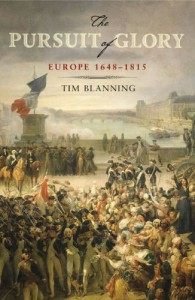
This is a thorough, engaging and informative history: it takes on a lot (more than 150 years of history in a whole slew of countries, in 677 pages), and does an excellent job with it, offering interesting detail, analysis and quotations by contemporary observers.
Interestingly, the book is organized topically rather than chronologically or geographically. The first section discusses transportation, population and daily life, the economy, agriculture and the status and rebellions of peasants. The second discusses rulers and governments in various countries and the overall trends under their reigns, as well as political trends and reforms. (Blanning seems to incline toward a "great man" view of history.) The third is about religion, royal courts, art and the Enlightenment. And the final section is all about wars and diplomacy. It’s a successful organization that allows the author to delve into each topic, observing how it manifested in various countries, without getting too caught up in the “traditional” history of battles and so on (though after reading the final section it was hard to imagine how anyone managed to get anything else done with all this constant fighting!). He's much more focused on drawing the meaning out of history than just telling us what happened when.
Unsurprisingly given the number of countries in Europe, all do not get equal treatment. There’s a lot about France, England, the Holy Roman Empire, the Habsburg Monarchy, Prussia and Russia. There’s some information about Spain, Italy, and the Netherlands. There’s very little about Scandanavia, Switzerland, Portugal, Denmark or Poland, and the part of Europe under Ottoman rule at the time might as well not have existed.
My real complaint about the book is that it doesn’t cite its sources; I realize this is a synthesis, and sources are sometimes referenced in the text itself, but this is still bad form in nonfictional writing.
Overall though, a very informative book that manages to relate large amounts of history through engaging narrative and well-reasoned argument. I recommend it.
 3
3
Deep Work by Cal Newport
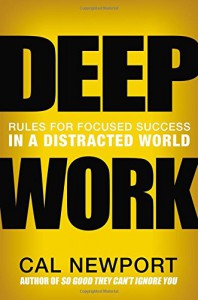
This is a very practical productivity book despite a big topic. The first third I found mostly worthless – it’s a long-winded sales pitch for working deeply, i.e., doing something that is intellectually challenging and requires focus. The last two-thirds though consist of practical advice, and sparked some serious thought about some of my habits. Some salient points:
- In the modern workplace, it’s often difficult for “knowledge workers” to gauge how well they are doing at their jobs, and easy to substitute the appearance of busyness (packing your schedule, quick email responses, etc.) for valuable work. But this leads to a trap where much of your work is easy rote stuff and doesn’t actually make use of your expertise.
- It can be hard to get your brain to focus on deep work, especially if you’ve trained it to reach for distraction the moment you’re a little bored or uncomfortable. For this reason, the author recommends not reaching for your phone every time you find yourself unoccupied for a few minutes (waiting in line and so on) – your instinct will be the same when asked to do something intellectually challenging. Let yourself be bored instead.
- Figure out when you can engage in deep work and schedule it. Having rituals around how you begin your work, and rules for the time when you’re doing it, can help keep you in the zone.
- It can also be helpful to keep a visible scoreboard for yourself and schedule a regular check-in to hold yourself accountable.
- You need downtime, to let you mull over things subconsciously and recharge energy. The author recommends leaving work by 5:30 (assuming a regular business schedule) and avoiding weekend work, arguing that the work done later in the evening is usually not that important and will only leave you more mentally tired.
- Schedule times when you allow distractions; schedule your day to make the best use of it. Structure your leisure time to avoid spending it just clicking low-value internet links.
- Be disciplined with use of email and social media. Even if you really do have to be regularly available by email, you can schedule regular check-in times rather than being constantly available.
A couple aspects that were less helpful to me:
- The book assumes that email and social media are massive distractions in the reader’s work and personal life, and recommends cutting back on them severely. Certain advice (not responding to unnecessary email or responding in such a way as to curtail back-and-forth; quitting social media altogether) is rather drastic if you already have a relatively healthy relationship with these tools.
- The author appears to have an unexamined but notable male-centric view of the world, and only manages to come up with a couple of female success stories in the entire book. I wondered at first if I was being overly sensitive to this before seeing that many other reviewers noticed the same.
- The anecdotes that begin most chapters are boring and can be skipped.
That said, I definitely found a lot of food for thought here and think this is a useful book overall, especially if you’re feeling overly distractible and want to add more focused, meaningful work to your life.
City of Light, City of Poison by Holly Tucker
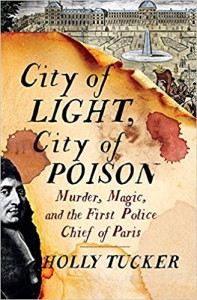
This true account of a massive criminal investigation in 1670’s Paris could have been much better. In brief, many people accused others of involvement in poison and witchcraft, and at least some of the poisoning seems to have been true (various poisons were in fact found in the possession of some of these folks, and in the case of one noblewoman, her father and brothers all really did die under similar and suspicious circumstances). Louis XIV appointed Nicolas de la Reynie police chief to reduce the high crime rate in Paris at the time (including lots of murders), but made him back off this particular investigation once fingers began to be pointed at some of Louis’s own mistresses.
It’s interesting stuff, and a quick read; you could likely read it in a single sitting if so inclined. That said, Tucker takes a somewhat novelistic, almost sensationalist approach, despite the fact that she does seem to stick to documented historical facts. There are many chapters about the doings of Louis’s mistresses and female associates (including the sudden death of his sister-in-law Henrietta Anne, sister of Charles II of England), which never really merge with the poison storyline. At best the history of the mistresses provides some background on why one or two of them might have been as cutthroat as was alleged (though only sort of; on their way out these women got significant parting gifts from the king), but it’s all indirect and spends a lot of time with mistresses who were never even implicated. After all the talk about Henrietta Anne I thought we’d get at least a theory on who might have poisoned her, but the author offers very little analysis in the end.
Because the author doesn’t really analyze the facts presented, it’s a bit hard to tell, but I had the impression she was more on the side of the authorities – and more inclined to believe the confessions of people who had been imprisoned for months or sometimes even years without trial, but with the ever-present threat of torture and execution – than I was. Judicial torture was a commonplace part of the process, though strangely, it occurred between sentencing and execution. (I don’t know if the examples the author presents are representative, but in the book, only one person provided meaningful new information under torture, and she later recanted.) The torture is described in unpleasant detail and recurs frequently throughout the book. Noblewomen fared far better in court than commoners, some of whom seem to have been convicted and executed before their cases were fully investigated. There’s a witch hunt quality to the whole thing in the figurative as well as literal sense, and by the time Marie-Anne Mancini told off the police chief in court I was cheering her on. Oddly there’s no discussion of the gender dynamics at play here either – given that most of the accused appear to have been women, that abortion was a major accusation and that a common motivation for women accused of poisoning seems to have been domestic abuse and/or escaping forced marriage.
At any rate, colorful history but not very substantive. The author certainly has storytelling skills, but the book is lightweight.
Princesses by Flora Fraser
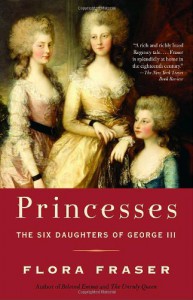
Interesting subject, but I fall into the camp that found Fraser's writing to be very dry, which makes this quite a long book. It seems like a substantial amount of it is undigested research - the royal family went to such-and-such a palace to celebrate such-and-such an occasion - maybe because it was intended to be more of an academic biography that simply records facts, but as a non-academic what I'm looking for in biographies is meaning. With all these quoted letters from the young princesses to their governesses apologizing for bad behavior, for instance: what do they actually tell us about the princesses and their lives and culture? What sort of behavior were the girls getting up to, and were some less obedient than others? Did they write the letters of their own volition or because another governess told them to? Without any of this context - which Fraser doesn't provide - quoting a few of these letters doesn't actually tell us anything. Isn't the historian's job to sort through all this primary source material and sift narrative and meaning out of it to share with the reader? Maybe I'm asking for more hand-holding than the type of writing Fraser aspired to here is meant to provide, but at any rate I quit at page 100. I debated a lot whether to continue though, since there is a lot of interesting information here and the six princesses seem to have had interesting lives.
 1
1















